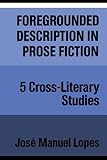Foregrounded Description in Prose Fiction : Five Cross-Literary Studies / José Lopes.
Material type: TextSeries: Theory / CulturePublisher: Toronto : University of Toronto Press, [1995]Copyright date: ©1995Description: 1 online resource (196 p.)Content type:
TextSeries: Theory / CulturePublisher: Toronto : University of Toronto Press, [1995]Copyright date: ©1995Description: 1 online resource (196 p.)Content type: - 9781442623064
- 9781442623248
- 809.3/85 20
- PN816 .L67 1995eb
- online - DeGruyter
| Item type | Current library | Call number | URL | Status | Notes | Barcode | |
|---|---|---|---|---|---|---|---|
 eBook
eBook
|
Biblioteca "Angelicum" Pont. Univ. S.Tommaso d'Aquino Nuvola online | online - DeGruyter (Browse shelf(Opens below)) | Online access | Not for loan (Accesso limitato) | Accesso per gli utenti autorizzati / Access for authorized users | (dgr)9781442623248 |
restricted access online access with authorization star
http://purl.org/coar/access_right/c_16ec
In this wide-ranging study, José Manuel Lopes proposes a theoretical framework for analysing the role of description in prose fiction. He offers readings of texts drawn from four national literatures-French, Spanish, Portuguese, and Brazilian-testing his model across a cultural and temporal spectrum. This critical breadth also illustrates the significance of description in disparate contexts: the postmodern novel, which implicitly challenges conventional notions of foreground and background, as well as the naturalist and realist fiction of the nineteenth century.Lopes applies his model to detailed readings of Emile Zola's Une Page d'amour, Claude Simon's Histoire, Benito Pérez Galdós' La de Bringas, Cornélio Penna's A Menina Morta, and Carlos de Oliveira's Finisterra. In addition to exploring the interplay of description and narration, these readings pay particular attention to spatial descriptions, and analyse the diverse roles of description in different contexts. After subjecting each fictional text to a detailed analysis which seeks to bring out the crucial aspects that contribute towards the foregrounding of descriptive passages (e.g., mise en abyme, parody, modes of representation), and which establishes, on occasion, certain relations that literary description may entertain with the other arts, he attempts to isolate the primary functions of foregrounding descriptions. What he seeks to demonstrate is that description constitutes a major textual component necessary for the analysis and understanding of both nineteenth- and twentieth-century fictional texts.
Mode of access: Internet via World Wide Web.
In English.
Description based on online resource; title from PDF title page (publisher's Web site, viewed 01. Nov 2023)


